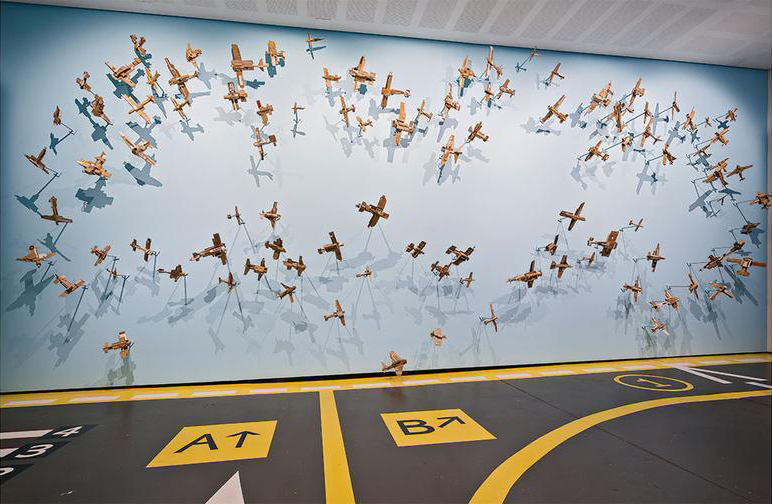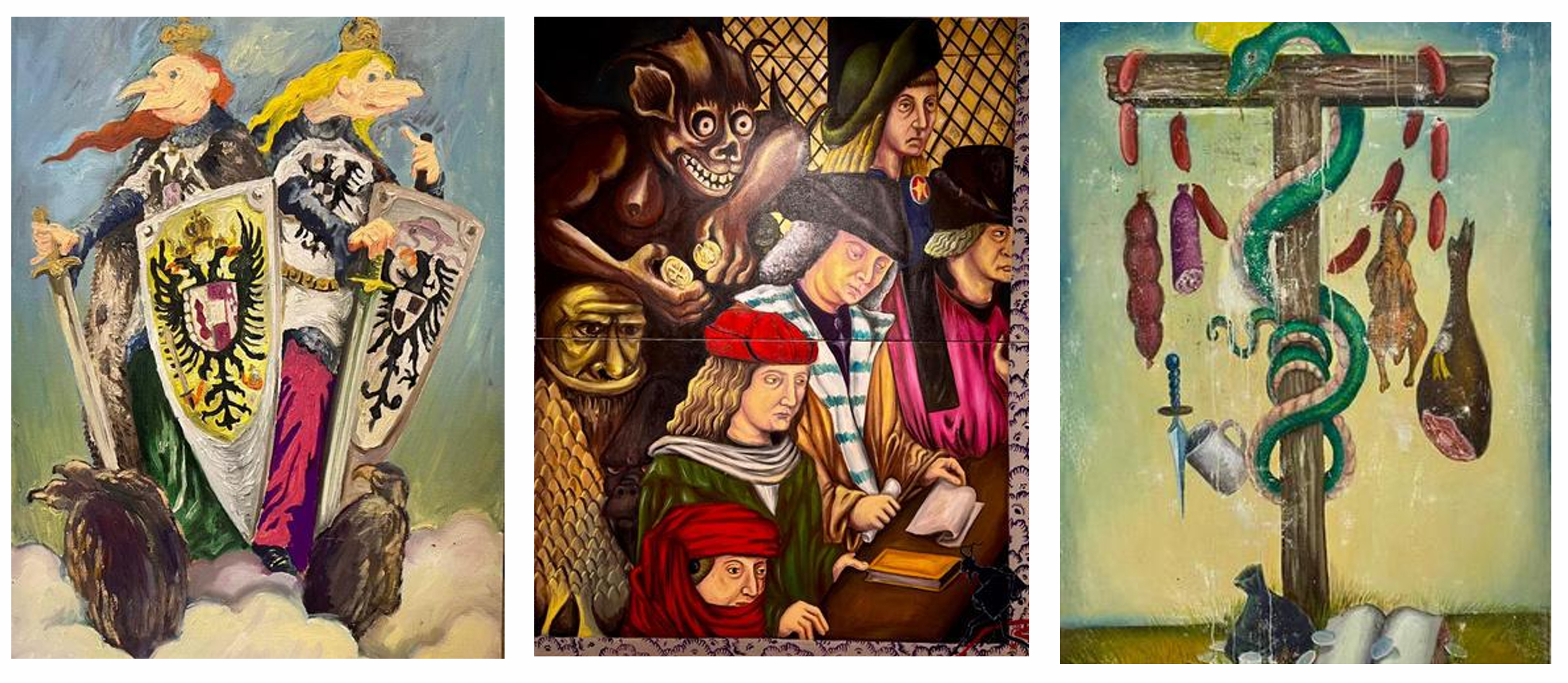Upcoming Exhibition
KoreanOca Villamiel
Born in 1953, Manila, Philippines

Oca Villamiel (b. 1953 Philippines)
Bahay ng Mangingisda
2025 Discarded nylon fish nets 152 x 213 x 152 cm
Oca Villamiel confronts the precarious conditions of life in his hometown of Barangay Caridad, Atimonan, a fishing community marked by poverty and hardship. Bahay ng Mangingisda recreates the scale of a fisherman’s hut from an immense mound of nylon fishnets. Implements for entrapment take the form of protective shelter, conjuring the tension between fragile refuge and the burden of scarcity.

Oca Villamiel (b. 1953 Philippines)
Traces
2022 685.8 x 137.16 cm
Oca Villamiel’s Traces is a haunting collection of 180 framed pieces made entirely of fish bones. On first encounter, the works appear delicate, almost ornamental, but their quiet arrangement carries the weight of lives marked by struggle. Each bone is a fragment of survival, a trace of scarcity. The series speaks to the persistence of poverty: even when the fish is gone, its skeleton remains, reminding us of hunger that has not disappeared.
Pete Jimenez
Born in 1960, Philippines

Pete Jimenez (b. 1960 Philippines)
Hard Rain
2025
Recycled steel shells from historical ordnance
cleaned and rendered safe for artistic display Total 180 pieces installation 14 m length
Hard Rain is an installation composed of more than a
hundred rusted steel scrap components from
decommissioned WWII artifacts. These inert reclaimed
steel casings from historical military equipment, carefully
cleaned and rendered safe, were collected over a decade
from Nueva Vizcaya and the Ifugao Province in the
Philippines. Local villagers unearthed recycled steel shells
from historical ordnance and dismantled vessels from
WWII-era scrap metal, selling them to antique pickers for
modest earnings that often helped meet daily needs.
Through this work, the artist transforms remnants of conflict
into a contemplative sculptural field - a landscape where
the traces of war are reconfigured into gestures of
resilience and renewal. What were once instruments of
destruction are now reassembled as symbols of survival,
reclaiming material histories through the act of making.

Pete Jimenez (b. 1960 Philippines)
Tall Order 5
2025
Wood and steel, 229 x 61 x 61 cm
Pete Jimenez transforms canoe-like dugouts of Bulakeño fisherfolk
into monumental forms in TALL ORDER. Through these weathered
vessels, he reflects on our deep reliance on water-both gift and
trial-while evoking struggles of survival, adaptability, and co
existence. The work also gestures toward tensions in disputed
waters, where human resilience confronts poverty, conflict, and the
will to endure.
Jimenez’s boats are not pristine relics but weathered, chipped, and
blistered vessels, their surfaces bearing scars of use and decay. He
sources them from fishing villages in Bulacan and Pampanga,
cutting and recomposing fragments into towering
sculptures that hover between memory and myth. In this
reconfiguration, each dugout becomes a symbolic locus-anchored in
community traditions of riverine life yet reaching into broader
narratives of territorial claim, ecological precarity, and the invisible
currents that bind people to place. His practice, rooted in repurposed
industrial and maritime detritus, underscores how cultural resilience
emerges from the margins and margins of circulation.
Alfredo & Isabel Aquilizan
Born in 1962, Cagayan Valley, Philippines, 1965, Manila, Philippines

Alfredo & Isabel Aquilizan (b. 1962, b. 1965 Philippines)
Arrivals and Departures: Project Another Country
2019-2025 Raw metal 100 x 40 cm (each)

Alfredo & Isabel Aquilizan (b. 1962, b. 1965 Philippines)
Flight/Path
2022 Cardboard and metal Dimensions variable
Yavuz’s artist duo, Isabel and Alfredo Aquilizan worked on a six month exploration of flight and were commissioned to create two works that utilise the overwhelming scale of Casula Powerhouse. Within the exhibition, there are two pieces of art: a wall installation and a floor painting. Transforming one of the gallery floors into an imaginative tarmac to encourage and stimulate visitors to wonder and experience the excitement of travel.
Elaine Navas
Born in 1964, Manila, Philippines
Elaine Navas (b. 1964 Philippines)
Nothing Moves Itself (After Ling Quisumbing)
2017 Oil on canvas 122 x 610 cm
Commissioning in Process
Elaine Navas’ series of paintings Nothing Moves Itself, inspired from a phrase by theologian Thomas Aquinas, and in dialogue with fellow artist Ling Quisumbing’s photographs, are contemplations on the idea of movement itself. The frozen moment of the sea is apparent in both photograph and painting, yet its motion is unmistakable, as Navas meticulously tries to capture the characteristics of each turn wave, each shift, each gradation to the next recurrence. Rendered in thick layers of paint which have become her signature, each painting becomes a frame from the idea of time-lapse which photography had brought into play. These recorded scenes are revealed to us as depictions of nature; while the transformation from photograph to canvas is a display of the artist's will.
Manuel Ocampo
Born in 1965, Quezon City, Philippines

Manuel Ocampo (b. 1965 Philippines)
Oil on Canvas
Commissioning in Process
This series presents paintings currently in development for the ‘Isang
Dipang Langit.’ exhibition. Each oil on canvas varies in scale and
format, together forming a cohesive body of work.
Manuel Ocampo’s painting philosophy rests on a deliberate clash of
the sacred and the profane, using loaded imagery-from Catholic
iconography to colonial emblems, swastikas, and cartoon figures-to
expose the fragility and corruption of symbols of power. By
subverting these icons of authority, Ocampo destabilizes meaning
itself, turning reverence into grotesque parody and solemnity into
absurd humor. His works resist purity, embracing hybridity and
contradiction as a way to mirror the postcolonial Filipino condition:
fragmented, messy, and constantly negotiating between Western
impositions and local realities.
Deploying an arsenal of art-historical and literary references,
religious and popular iconography, Ocampo’s complex paintings
weave together various visual vocabularies, creating implied
meaning through accumulation and its interrelationships. Presented
to viewers in a way that remains deliberately opaque, the symbols
and its formal properties that render them - their vivid colours,
energetic gestures and course brushstrokes - open up a spectrum of
interpretations that defies easy definitions
Russ Ligtas
Born in 1985, Cebu, Philippines

Russ Ligtas (b. 1985 Philippines)
The Last Hapi
2025 Video installation, Running time: 90 minutes
Dimensions variable
Russ Ligtas’ The Last Hapi is an exploration of identity, memory, and
myth, framed as both a ritual and a self-portrait. Drawing from his
experience as a Filipino navigating diaspora, Ligtas weaves together
fragments of history, personal narrative, and cultural imagination to
question what “Filipino-ness” might mean today.
The work unfolds as a hybrid: a film that is also ritual, a performance that
becomes an installation. At its center is stillness-an insistence on breath
and silence in a world crowded with noise. The presence of a seated
figure within the space, watching alongside the audience, transforms
viewing into an act of reflection and mirroring.
By reference 1972, the year Martial Law was declared in the Philippines,
the piece gestures toward historical trauma while refusing to fix meaning.
The Hapi’s disappearance may serve as metaphor, allegory, or simply
myth. In this way, Ligtas leaves room for multiple readings-academic,
political, or personal.
The installation space, envisioned as either a dark cinematic environment
or an intimate living room, invites audiences into a porous bubble of
contemplation. Here, Ligtas offers not answers, but a mirror: a chance to
see ourselves in contradiction, and perhaps to find grace in the reflection.
Dominic Mangila
Born in 1978, Manila, Philippines

Dominic Mangila (b. 1978, Philippines)
Manongs of Louisiana
2025 Oil on canvas 200 x 150 cm (each)
Commissioning in Process
The exhibition presents recent paintings by Dominic
Mangila that reference Filipino migrant workers who came
to the United States in the early 20th century - the farm
laborers ‘Manong Generation’ of California’s Pajaro Valley,
Hawaii and the shrimp farmers of Louisiana. It also
features a six-panel painting which references an archive
on International Hotel. The archive is culled from the
Watsonville Is In the Hearts (WIITH) - a community
engaged research initiative based at the University of
Santa Cruz (UCSC).
Dominic Mangila explores the cross-fertilization of
abstraction in disparate forms in painting. To prod
painting’s other unknown sphere, he explores the
reconsideration of the brushstroke as a performative
signature of the mind’s interiority and the individual
aesthetic gesture of the body’s phenomenological
sensitivity to all that is present in the painting studio.
Eisa Jocson
Born in 1986, Manila, Philippines

Eisa Jocson (b. 1986, Philippines)
Pasyoke
2020 Video and installation, sound 17 min. 58 sec. Dimensions variable
Commissioned by the Goethe-Institute in the United Arab Emirates
Eisa Jocson’s latest project, the performance-video Pasyoke (derived from Spanish Pasqua for Easter and Karaoke) by The Filipina Superwoman Band, which unravels as an expansion of her body of work around notions of the Filipino singing culture as a state-supported export, mimicry in the music industry, and Snow White and Superwoman as archetypes. The band is an all-female musical ensemble responding to the "Overseas Filipino Musician" (OFM) phenomenon in clubs, bars, hotels and cruise boats throughout Asia and the Middle East. A cross between contemporary dance and music video, Pasyoke merges genres, combining Pasyón, a 16th-century epic Biblical narration of Jesus’s life, death and resurrection, with Bidyoke - karaoke gatherings customary in the Philippines for celebrations. The project was conceived as a research project that would have seen Eisa Jocson spending time as an artist-in residence in Dubai. These plans were thwarted by the pandemic and the little research that was still possible was done remotely, while the production took place mostly in the Philippines instead of the UAE.
Leeroy New
Born in 1986, General Santos City, Philippines

Leeroy New (b. 1986, Philippines)
Bird Nests
2025 Bamboo, recycled plastic and found objects assembled Size variable
Leeroy New’s bird nest-inspired installation sculptures
are notable for transforming everyday discarded materials
into complex, biomorphic forms that evoke the creative
ingenuity of avian nest building, while addressing
environmental and social themes. These works often
feature organic, swirl-like structures made from recycled
plastics, electrical tubing, and hardware sourced objects,
combining art, social commentary, and ecological
consciousness.
Leeroy New reimagines the methodologies of birds in
collecting nesting materials by foraging and assembling
local, found objects such as plastics, irrigation hoses, and
cable ties into large-scale installations. Like birds who
use leaves, bark, and fibers, New draws parallels
between natural and human-made materials-his
sculptures often become “time capsules” containing both
cultural and environmental narratives. The forms echo
nests and root systems, referencing the Balete tree in
Southeast Asia, and invoke themes of resourcefulness
often found in Filipino communities who repurpose
leftovers into decorative objects.
